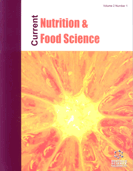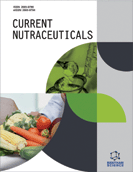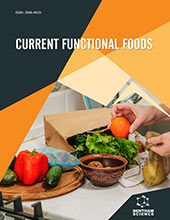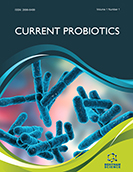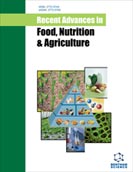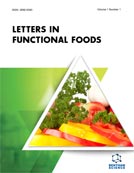Abstract
Background: The World Health Organization determines cardiovascular diseases as the most wide-spread diseases in the world. They are the main reason for human death in most countries. Functional food enriched with essential micronutrients, such as ω-3 fatty acids, are one means of such diseases' prevention. Micro- and nano-encapsulation of fatty acids contributes to their safety and prevents changes to the organoleptic properties of the products when introduced in a recipe.
Objective: This paper aims to present a method for enriching bread with ω-3 fatty acids using a liposomal polyunsaturated fatty acids (PUFAs) concentrate obtained from seal fat.
Methods: The authors developed the PUFAs concentrate using the complex formation method with urea. They introduced a liposomal suspension with the PUFAs concentrate into a bread recipe by replacing part of the water. Gas chromatography-mass spectrometry was used to determine the fatty acid composition of the oil in the bread. The authors also evaluated the organoleptic characteristics of the bread samples and the ability of the bread to crumble, as an indication of the degree of bread staling.
Results: The authors identified the optimal dose of ω-3 PUFAs concentrate in a liposomal form obtained from seal fat to fortify bread. Fatty acid analysis of the bread lipids confirmed the increase in ω-3 fatty acids content in the final product. Increasing the content of ω-3 fatty acids changed the ω-6/ω-3 ratio. The introduction of this additive into the bread recipe also augmented the bread volume yield and crust color intensification, and reduced the degree of bread staling. Moreover, the method used to incorporate the additive did not alter the bread taste and flavor.
Conclusion: The findings prove that micro- and nano-encapsulation allow obtaining a food product with good organoleptic characteristics and consumer-desired product properties. The consumption of functional food enriched with essential micronutrients, such as ω-3 PUFAs, is one of the ways to prevent cardiovascular diseases.
Keywords: Bread, food biotechnology, functional food, essential micronutrients, enrichment, unsaturated fatty acids.
Graphical Abstract
Current Nutrition & Food Science
Title:The Use of Unsaturated Fatty Acids in Liposomal Form to Get Bread Enriched with ω-3 Fatty Acids
Volume: 14 Issue: 1
Author(s): Tatyana Kozlova, Erzhena Syngeeva, Sesegma Zhamsaranova and Galina Lamazhapova*
Affiliation:
- Department of Biotechnology, Institute of Food Engineering and Biotechnology, East-Siberia State University of Technology and Management, Ulan-Ude,Russian Federation
Keywords: Bread, food biotechnology, functional food, essential micronutrients, enrichment, unsaturated fatty acids.
Abstract: Background: The World Health Organization determines cardiovascular diseases as the most wide-spread diseases in the world. They are the main reason for human death in most countries. Functional food enriched with essential micronutrients, such as ω-3 fatty acids, are one means of such diseases' prevention. Micro- and nano-encapsulation of fatty acids contributes to their safety and prevents changes to the organoleptic properties of the products when introduced in a recipe.
Objective: This paper aims to present a method for enriching bread with ω-3 fatty acids using a liposomal polyunsaturated fatty acids (PUFAs) concentrate obtained from seal fat.
Methods: The authors developed the PUFAs concentrate using the complex formation method with urea. They introduced a liposomal suspension with the PUFAs concentrate into a bread recipe by replacing part of the water. Gas chromatography-mass spectrometry was used to determine the fatty acid composition of the oil in the bread. The authors also evaluated the organoleptic characteristics of the bread samples and the ability of the bread to crumble, as an indication of the degree of bread staling.
Results: The authors identified the optimal dose of ω-3 PUFAs concentrate in a liposomal form obtained from seal fat to fortify bread. Fatty acid analysis of the bread lipids confirmed the increase in ω-3 fatty acids content in the final product. Increasing the content of ω-3 fatty acids changed the ω-6/ω-3 ratio. The introduction of this additive into the bread recipe also augmented the bread volume yield and crust color intensification, and reduced the degree of bread staling. Moreover, the method used to incorporate the additive did not alter the bread taste and flavor.
Conclusion: The findings prove that micro- and nano-encapsulation allow obtaining a food product with good organoleptic characteristics and consumer-desired product properties. The consumption of functional food enriched with essential micronutrients, such as ω-3 PUFAs, is one of the ways to prevent cardiovascular diseases.
Export Options
About this article
Cite this article as:
Kozlova Tatyana , Syngeeva Erzhena , Zhamsaranova Sesegma and Lamazhapova Galina *, The Use of Unsaturated Fatty Acids in Liposomal Form to Get Bread Enriched with ω-3 Fatty Acids, Current Nutrition & Food Science 2018; 14 (1) . https://dx.doi.org/10.2174/1573401313666170316114252
| DOI https://dx.doi.org/10.2174/1573401313666170316114252 |
Print ISSN 1573-4013 |
| Publisher Name Bentham Science Publisher |
Online ISSN 2212-3881 |
 31
31 4
4 1
1
- Author Guidelines
- Bentham Author Support Services (BASS)
- Graphical Abstracts
- Fabricating and Stating False Information
- Research Misconduct
- Post Publication Discussions and Corrections
- Publishing Ethics and Rectitude
- Increase Visibility of Your Article
- Archiving Policies
- Peer Review Workflow
- Order Your Article Before Print
- Promote Your Article
- Manuscript Transfer Facility
- Editorial Policies
- Allegations from Whistleblowers
- Announcements
Related Articles
-
Heterocycles in the Treatment of Neglected Tropical Diseases
Current Medicinal Chemistry The Promises and Challenges of the Use of Genomics in the Prescription of Exercise in Hypertension
Current Hypertension Reviews Role of Chymase in Preeclampsia
Current Vascular Pharmacology Procyanidins and Their Healthy Protective Effects Against Type 2 Diabetes
Current Medicinal Chemistry Management of Hypertension-Journey from Single Drug Therapy to Multitargeted Ligand Therapy: A Clinical Overview
Current Clinical Pharmacology Tracking the Mesenchymal Stem Cell Fate After Transplantation Into the Infarcted Myocardium
Current Stem Cell Research & Therapy Hypereosinophilic Syndrome, Churg-Strauss Syndrome and Parasitic Diseases: Possible Links between Eosinophilia and Thrombosis
Current Vascular Pharmacology Glucocorticoids and the Cardiovascular System: State of the Art
Current Pharmaceutical Design Social Determinants, Race, and Brain Health Outcomes: Findings from the Chicago Health and Aging Project
Current Alzheimer Research Biomarkers in Lone Atrial Fibrillation-An Additional ‘Fine Tuning’ of Risk?
Current Pharmaceutical Design Epigenetic control of cardiovascular health by nutritional polyphenols involves multiple chromatin-modifying writer-reader-eraser proteins
Current Topics in Medicinal Chemistry Regular Physical Activity and Vascular Aging
Current Pharmaceutical Design Imaging of Visceral Adipose Tissue: An Emerging Diagnostic Tool and Therapeutic Target
Current Drug Targets - Cardiovascular & Hematological Disorders Advances in the Treatment of Neurodegenerative Disorders Employing Nanoparticles
Recent Patents on Drug Delivery & Formulation Common Comorbidities that Alter Heart Failure Prognosis - Shaping New Thinking for Practice
Current Cardiology Reviews Bispidine as a Privileged Scaffold
Current Topics in Medicinal Chemistry Stress and Vulnerability Due to the Care Task: An Observational Study on Older Caregivers
Current Psychopharmacology Inflammation-Mediating Proteases: Structure, Function in (Patho) Physiology and Inhibition
Protein & Peptide Letters Does Non-Alcoholic Fatty Liver Disease (NAFLD) Increase Cardiovascular Risk?
Endocrine, Metabolic & Immune Disorders - Drug Targets Terminalia arjuna in Cardiovascular Diseases: Making the Transition from Traditional to Modern Medicine in India
Current Pharmaceutical Biotechnology


